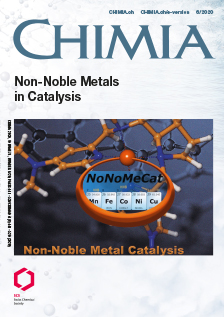Bioinspired Non-Heme Iron Complexes: The Evolution of Facial N, N, O Ligand Design
DOI:
https://doi.org/10.2533/chimia.2020.450PMID:
32560750Keywords:
Bioinspired metal complexes, 2-his-1-carboxylate facial triad, N,n,o ligands, Non-heme ironAbstract
Iron-containing metalloenzymes that contain the 2-His-1-Carboxylate facial triad at their active site are well known for their ability to activate molecular oxygen and catalyse a broad range of oxidative transformations. Many of these reactions are synthetically challenging, and developing small molecular iron-based catalysts that can achieve similar reactivity and selectivity remains a long-standing goal in homogeneous catalysis. This review focuses on the development of bioinspired facial N,N,O ligands that model the 2-His-1-Carboxylate facial triad to a greater degree of structural accuracy than many of the polydentate N-donor ligands commonly used in this field. By developing robust, well-defined N,N,O facial ligands, an increased understanding could be gained of the factors governing enzymatic reactivity and selectivity.Downloads
Published
2020-06-24
Issue
Section
Scientific Articles
License
Copyright (c) 2020 Emily C. Monkcom, Pradip Ghosh, Emma Folkertsma, Hidde A. Negenman, Martin Lutz, Robertus J. M. Klein Gebbink

This work is licensed under a Creative Commons Attribution-NonCommercial 4.0 International License.
How to Cite
[1]
E. C. Monkcom, P. Ghosh, E. Folkertsma, H. A. Negenman, M. Lutz, R. J. M. Klein Gebbink, Chimia 2020, 74, 450, DOI: 10.2533/chimia.2020.450.







